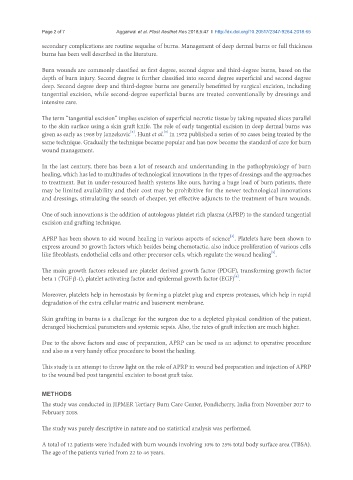Page 351 - Read Online
P. 351
Page 2 of 7 Aggarwal et al. Plast Aesthet Res 2018;5:47 I http://dx.doi.org/10.20517/2347-9264.2018.65
secondary complications are routine sequelae of burns. Management of deep dermal burns or full thickness
burns has been well described in the literature.
Burn wounds are commonly classified as first degree, second degree and third-degree burns, based on the
depth of burn injury. Second degree is further classified into second degree superficial and second degree
deep. Second degree deep and third-degree burns are generally benefitted by surgical excision, including
tangential excision, while second-degree superficial burns are treated conventionally by dressings and
intensive care.
The term “tangential excision” implies excision of superficial necrotic tissue by taking repeated slices parallel
to the skin surface using a skin graft knife. The role of early tangential excision in deep dermal burns was
[3]
[2]
given as early as 1968 by Janzekovic . Hunt et al. in 1972 published a series of 50 cases being treated by the
same technique. Gradually the technique became popular and has now become the standard of care for burn
wound management.
In the last century, there has been a lot of research and understanding in the pathophysiology of burn
healing, which has led to multitudes of technological innovations in the types of dressings and the approaches
to treatment. But in under-resourced health systems like ours, having a huge load of burn patients, there
may be limited availability and their cost may be prohibitive for the newer technological innovations
and dressings, stimulating the search of cheaper, yet effective adjuncts to the treatment of burn wounds.
One of such innovations is the addition of autologous platelet rich plasma (APRP) to the standard tangential
excision and grafting technique.
[4]
APRP has been shown to aid wound healing in various aspects of science . Platelets have been shown to
express around 30 growth factors which besides being chemotactic, also induce proliferation of various cells
[5]
like fibroblasts, endothelial cells and other precursor cells, which regulate the wound healing .
The main growth factors released are platelet derived growth factor (PDGF), transforming growth factor
[6]
beta 1 (TGF β-1), platelet activating factor and epidermal growth factor (EGF) .
Moreover, platelets help in hemostasis by forming a platelet plug and express proteases, which help in rapid
degradation of the extra cellular matric and basement membrane.
Skin grafting in burns is a challenge for the surgeon due to a depleted physical condition of the patient,
deranged biochemical parameters and systemic sepsis. Also, the rates of graft infection are much higher.
Due to the above factors and ease of preparation, APRP can be used as an adjunct to operative procedure
and also as a very handy office procedure to boost the healing.
This study is an attempt to throw light on the role of APRP in wound bed preparation and injection of APRP
to the wound bed post tangential excision to boost graft take.
METHODS
The study was conducted in JIPMER Tertiary Burn Care Center, Pondicherry, India from November 2017 to
February 2018.
The study was purely descriptive in nature and no statistical analysis was performed.
A total of 12 patients were included with burn wounds involving 10% to 25% total body surface area (TBSA).
The age of the patients varied from 22 to 46 years.

